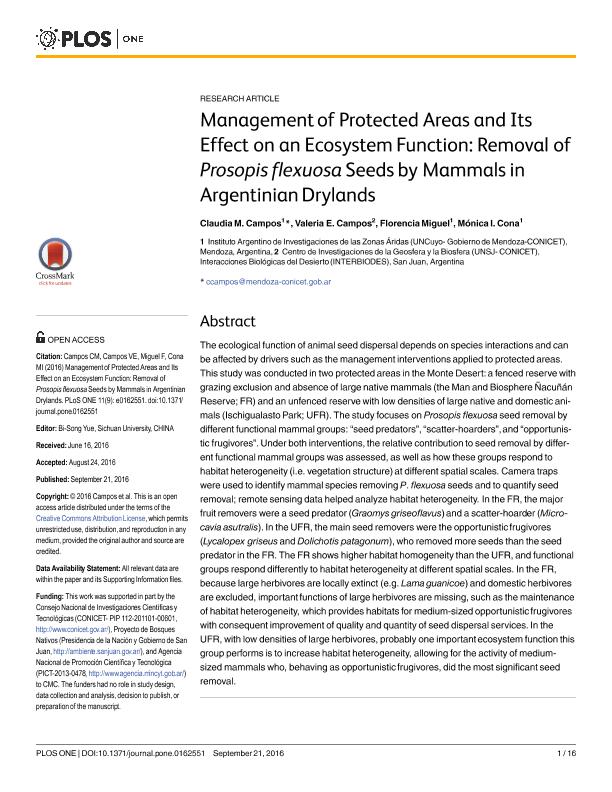Mostrar el registro sencillo del ítem
dc.contributor.author
Campos, Claudia Monica

dc.contributor.author
Campos, Valeria Evelin

dc.contributor.author
Miguel, María Florencia

dc.contributor.author
Cona, Monica Ines

dc.date.available
2018-05-15T19:49:38Z
dc.date.issued
2016-09-21
dc.identifier.citation
Campos, Claudia Monica; Campos, Valeria Evelin; Miguel, María Florencia; Cona, Monica Ines; Management of protected areas and its effect on an ecosystem function: Removal of Prosopis flexuosa seeds by mammals in argentinian drylands; Public Library of Science; Plos One; 11; 9; 21-9-2016; 1-16; e0162551
dc.identifier.issn
1932-6203
dc.identifier.uri
http://hdl.handle.net/11336/45263
dc.description.abstract
The ecological function of animal seed dispersal depends on species interactions and can be affected by drivers such as the management interventions applied to protected areas. This study was conducted in two protected areas in the Monte Desert: a fenced reserve with grazing exclusion and absence of large native mammals (the Man and Biosphere Ñacuñán Reserve; FR) and an unfenced reserve with low densities of large native and domestic animals (Ischigualasto Park; UFR). The study focuses on Prosopis seed removal by different functional mammal groups: "seed predators", "scatterhoarders", and "opportunistic frugivores". Under both interventions, the relative contribution to seed removal by different functional mammal groups was assessed, as well as how these groups respond to habitat heterogeneity (i.e. vegetation structure) at different spatial scales. Camera traps were used to identify mammal species removing Prosopis seeds and to quantify seed emoval; remote sensing data helped analyze habitat heterogeneity. In the FR, the major fruit removers were a seed predator (Graomys griseoflavus) and a scatter-hoarder (Microcavia asutralis). In the UFR, the main seed removers were the opportunistic frugivores (Lycalopex griseus and Dolichotis patagonum), who removed more seeds than the seed predator in the FR. The FR shows higher habitat homogeneity than the UFR, and functional groups respond differently to habitat heterogeneity at different spatial scales. In the FR, because large herbivores are locally extinct (e.g. Lama guanicoe) and domestic herbivores are excluded, important functions of large herbivores are missing, such as the maintenance of habitat heterogeneity, which provides habitats for medium-sized opportunistic frugivores with consequent improvement of quality and quantity of seed dispersal services. In the UFR, with low densities of large herbivores, probably one important ecosystem function this group performs is to increase habitat heterogeneity, allowing for the activity of medium-sized mammals who, behaving as opportunistic frugivores, did the most significant seed removal.
dc.format
application/pdf
dc.language.iso
eng
dc.publisher
Public Library of Science

dc.rights
info:eu-repo/semantics/openAccess
dc.rights.uri
https://creativecommons.org/licenses/by-nc-sa/2.5/ar/
dc.subject
Monte
dc.subject
Frugivore
dc.subject
Scatter-Hoarder
dc.subject
Seed Predator
dc.subject
Vegetation Structure
dc.subject
Fenced Reserve
dc.subject
Unfenced Reserve
dc.subject.classification
Otras Ciencias Biológicas

dc.subject.classification
Ciencias Biológicas

dc.subject.classification
CIENCIAS NATURALES Y EXACTAS

dc.title
Management of protected areas and its effect on an ecosystem function: Removal of Prosopis flexuosa seeds by mammals in argentinian drylands
dc.type
info:eu-repo/semantics/article
dc.type
info:ar-repo/semantics/artículo
dc.type
info:eu-repo/semantics/publishedVersion
dc.date.updated
2018-04-18T15:10:15Z
dc.journal.volume
11
dc.journal.number
9
dc.journal.pagination
1-16; e0162551
dc.journal.pais
Estados Unidos

dc.journal.ciudad
San Francisco
dc.description.fil
Fil: Campos, Claudia Monica. Consejo Nacional de Investigaciones Científicas y Técnicas. Centro Científico Tecnológico Conicet - Mendoza. Instituto Argentino de Investigaciones de las Zonas Áridas. Provincia de Mendoza. Instituto Argentino de Investigaciones de las Zonas Áridas. Universidad Nacional de Cuyo. Instituto Argentino de Investigaciones de las Zonas Áridas; Argentina
dc.description.fil
Fil: Campos, Valeria Evelin. Consejo Nacional de Investigaciones Científicas y Técnicas. Centro Científico Tecnológico Conicet - San Juan. Centro de Investigaciones de la Geosfera y Biosfera. Universidad Nacional de San Juan. Facultad de Ciencias Exactas Físicas y Naturales. Centro de Investigaciones de la Geosfera y Biosfera; Argentina
dc.description.fil
Fil: Miguel, María Florencia. Consejo Nacional de Investigaciones Científicas y Técnicas. Centro Científico Tecnológico Conicet - Mendoza. Instituto Argentino de Investigaciones de las Zonas Áridas. Provincia de Mendoza. Instituto Argentino de Investigaciones de las Zonas Áridas. Universidad Nacional de Cuyo. Instituto Argentino de Investigaciones de las Zonas Áridas; Argentina
dc.description.fil
Fil: Cona, Monica Ines. Consejo Nacional de Investigaciones Científicas y Técnicas. Centro Científico Tecnológico Conicet - Mendoza. Instituto Argentino de Investigaciones de las Zonas Áridas. Provincia de Mendoza. Instituto Argentino de Investigaciones de las Zonas Áridas. Universidad Nacional de Cuyo. Instituto Argentino de Investigaciones de las Zonas Áridas; Argentina
dc.journal.title
Plos One

dc.relation.alternativeid
info:eu-repo/semantics/altIdentifier/doi/http://dx.doi.org/10.1371/journal.pone.0162551
dc.relation.alternativeid
info:eu-repo/semantics/altIdentifier/url/http://journals.plos.org/plosone/article?id=10.1371/journal.pone.0162551
Archivos asociados
